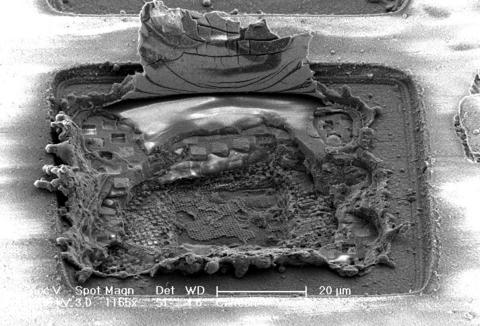One of the challenges of working with integrated circuits is as designers try to make ICs faster, the transistors become smaller and can’t handle as much voltage and the amount of variation grows. Plus, a single fault in the IC could mean a useless chip, bringing projects and products to sudden jarring halt.

Consequently, for the last five years or so, a team of researchers at the California Institute of Technology has been working to create self-healing ICs. Earlier this year, researchers from the High-Speed Integrated Circuits laboratory in Caltech’s Division of Engineering and Applied Science, demonstrated the self-healing abilities of the chip. The team use a laser to destroy parts of a chip and allowed the chip to assess the damage and reconfigure itself to work without the destroyed parts.
“It’s a biologically inspired system with sensors that can detect functionality and modify remaining circuits,” says Ali Hajimiri, PhD, a professor of Electrical Engineering at CalTech. “We needed a system that could identify and correct as it goes.”
To test the system in the case of partial and total transistor failure, the team cut out parts of an amplifier—first half of the CH transistor, followed by half of the CG transistor and then the entire stage—allowing for self-healing at each level, according to the paper published in IEEE Transactions on Microwave Theory and Techniques. They found that although the performance degraded, the ability to heal the degradation increased.
The system acts similarly to an immune system, says lead designer Steven Bowers, a graduate student in Electrical Engineering at Caltech. Though the initial aim for the project was to use the digital processing strengths of foundries to maintain very aggressive high-performance analog designs, self-healing is also a solution for that issue.
“We created an immune system with sensors on the chip to detect the performance, feed that data to a digital core that acts as the system’s immune system, and can control enough actuation points on the chip to correct for any expected—and even sometimes unexpected—variation on the chip that degrades the performance,” Bowers says. “Everything is integrated on the chip, which means that it can heal itself without the need for any expensive lab measurement equipment. “
It seems, however, that this is just the beginning of the application possibilities for the self-healing ICs. Aside from the healing the process variation of transistors, the ICs can also heal issues with environmental factors like temperature variation or load mismatch, according to Bowers.
“If the amplifier is connected to an antenna, and the environment interacts with the near-field of the antenna, the load impedance will change, and the power provided by the amplifier will drop. This can be seen in some cell phones that lose signal when they are held in certain ways. Our system can detect that degradation, and change its impedance matching network to match to whatever the new load is, maintaining a constant output power delivered to the antenna,” Bowers says. “Finally, we wanted to test the system in the extreme case of transistor failure. Because of the aggressive design, the output amplifying transistors are the ones that operate the closest to breakdown, and are likely to be the first ones that might fail. To assist in that failure, we used an optical laser cutter to destroy one of the output transistors, and the system was able to automatically heal and recover most of the performance lost by the blast.”
The applications (both current and future) could have a great impact in the field. Currently, the self-healing can be used on any analog circuit where the variation between transistors causes “significant performance degradation,” according to Bowers. This includes: cell phone transceivers, WiFi or wireless HD transceivers and portable mm-Wave image systems. As for the future, Bowers is most excited about the scalability of the technology as nodes become smaller and process variation increases dramatically.
“At the 45 nm node of this project, the process variation was enough to warrant using the self-healing system, and gave us an advantage over the system without self-healing, but its benefit was limited to about a 50 percent improvement in performance in most cases.” Bowers says. “I believe that we are just at the tip of the iceberg of the potential for self-healing systems.”